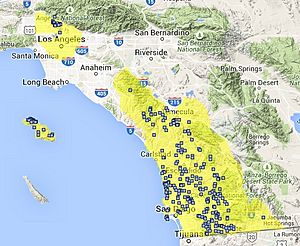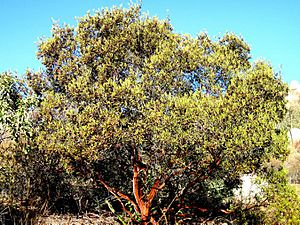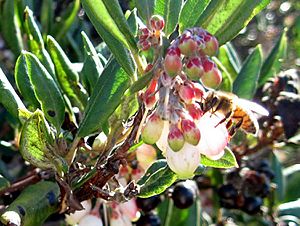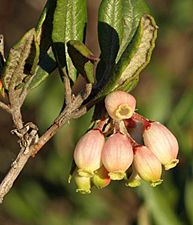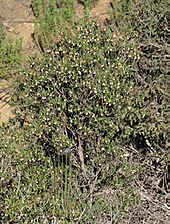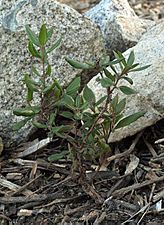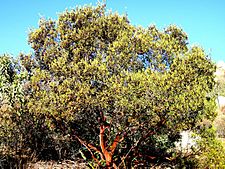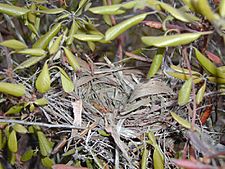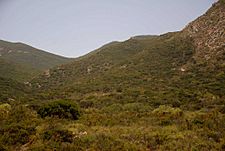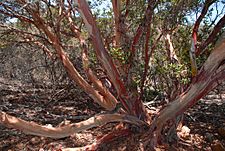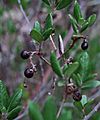Mission manzanita facts for kids
Quick facts for kids Mission manzanita |
|
|---|---|
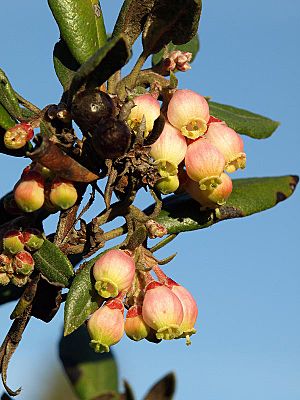 |
|
| Xylococcus bicolor in bloom with old fruit and leaves | |
| Scientific classification | |
| Genus: |
Xylococcus (plant)
|
| Species: |
bicolor
|
The Xylococcus is a special type of flowering plant. It belongs to the heath family. This group only has one species, which is called Xylococcus bicolor. Most people know it as the mission manzanita.
This plant is related to the well-known manzanitas, which are in the Arctostaphylos group. Both are part of the Ericaceae family. Long ago, the mission manzanita was even called Arctostaphylos bicolor. The name Xylococcus comes from ancient Greek words. It means "wood berry."
Contents
Where Mission Manzanita Grows
This plant grows in a very specific area. You can find it in the Peninsular Ranges of Southern California in the U.S. It also grows in northern Baja California state in Mexico. You can see it along the South Coast of California and the northwestern Baja California coast. It also lives on Santa Catalina Island.
Most of these plants are found in San Diego County, California and Baja California. The mission manzanita is a key part of the chaparral plant community. This community is found in the California chaparral and woodlands and California coastal sage and chaparral ecoregions. It likes to grow on dry, sunny hillsides. You will find it at elevations below 3,500 feet (about 1,067 meters).
What Mission Manzanita Looks Like
Xylococcus bicolor is a shrub that grows slowly. It looks a lot like other manzanita plants. It usually grows straight up with many stems. Its top part often forms a round shape. This shrub can grow up to 16 feet (5 meters) tall. It can also spread out to 10 feet (3 meters) wide.
Its leaves are long and oval-shaped. The top side is shiny and dark green. The underside is very light in color and feels soft, like felt. As the leaves get older, their edges curl under. The bark of the plant is smooth. It has a reddish-gray color.
The flowers of the mission manzanita appear from December to February. The exact time depends on how much rain falls. The flowers are white or pink. They become yellowish at their open end. Each flower is about 0.3 to 0.4 inches (8–10 mm) long. They hang down like tiny bells in small groups near the ends of branches.
The fruit is shiny and dark red, almost black. It is about 0.27 inches (7 mm) wide. The fruit has very little soft part. It is mostly a large, hard, woody seed.
- Mission manzanita
Mission Manzanita and Its Environment
Many animals interact with the mission manzanita. Birds like the California thrasher and scrub jay eat its seeds. Hummingbirds, especially the Anna's hummingbird, drink nectar from its flowers. Various birds also build their nests in the plant. Many animals use it for shelter and to hide.
Some plants in the chaparral need fire to help their seeds grow. However, Xylococcus bicolor is different. It does not need fire to sprout new plants. But, since it lives in the chaparral, it must be able to survive wildfires. It does this by growing new shoots from its base after a fire burns the top part. This method works very well. But if another fire happens too soon after the first, the plant might not have enough time to recover. In that case, it might die.
How People Use Mission Manzanita
The Native American Luiseño people used this plant. They would crush the ripe berries. Then, they would soak them in cold water overnight. This process made a drink that was similar to cider.
Growing Mission Manzanita
Xylococcus bicolor is grown as an ornamental plant. Special plant nurseries sell it. People plant it in California native plant gardens and wildlife gardens. It likes its leaves to be in full sun. But it prefers its roots to be in the shade. It needs soil that drains water quickly. The soil should have a pH between 6 and 7. It grows best in USDA zones 7–10.
The best time to plant mission manzanita is in late autumn. It does well on dry, rocky slopes. Putting a thick layer of mulch and some large rocks over the roots helps keep the soil moist in summer. In gardens, it likes light watering about once every two weeks during its first summer. Once it is established, it can usually survive dry months without extra water. However, it can handle watering once a month for its first 2–3 years. The plant prefers to have its leaves in full sun. But it likes its roots to be in the shade. It grows best on slopes that face north.
Gallery
- Ecology
Images for kids
See also
 In Spanish: Xylococcus bicolor para niños
In Spanish: Xylococcus bicolor para niños


